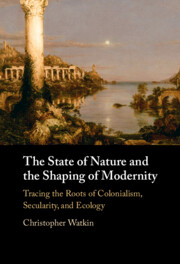Refine search
Actions for selected content:
192 results

The State of Nature and the Shaping of Modernity
- Tracing the Roots of Colonialism, Secularity, and Ecology
-
- Published online:
- 19 November 2025
- Print publication:
- 18 December 2025
Hume and Darwin: Epicurean Systems of Godless Naturalism
-
- Journal:
- Dialogue: Canadian Philosophical Review / Revue canadienne de philosophie , First View
- Published online by Cambridge University Press:
- 30 October 2025, pp. 1-20
-
- Article
- Export citation
Introduction
-
-
- Book:
- Science and Humanism
- Published online:
- 09 October 2025
- Print publication:
- 23 October 2025, pp 1-8
-
- Chapter
-
- You have access
- Open access
- HTML
- Export citation
Chapter 8 - The Pragmatic and the Religious Functions of Science
- from Part II - Inspirations
-
-
- Book:
- Science and Humanism
- Published online:
- 09 October 2025
- Print publication:
- 23 October 2025, pp 172-194
-
- Chapter
-
- You have access
- Open access
- HTML
- Export citation

Science and Humanism
- Knowledge, Values, and the Common Good
-
- Published online:
- 09 October 2025
- Print publication:
- 23 October 2025
-
- Book
-
- You have access
- Open access
- Export citation
Chapter 25 - Late-Victorian Theatre and the New Drama
- from Part IV - ‘Be contemporaneous’
-
-
- Book:
- Michael Field in Context
- Published online:
- 03 October 2025
- Print publication:
- 25 September 2025, pp 230-238
-
- Chapter
- Export citation
3 - An Anticolonial Critique of Sovereignty
- from Part I - Activists, Intellectuals, and Movements
-
-
- Book:
- Anticolonialism and Social Thought
- Published online:
- 16 September 2025
- Print publication:
- 25 September 2025, pp 69-90
-
- Chapter
- Export citation
Chapter 1 - Naturalism
- from Part I - Forms and Genres
-
-
- Book:
- The Cambridge Companion to Modernist Theatre
- Published online:
- 28 August 2025
- Print publication:
- 11 September 2025, pp 21-38
-
- Chapter
- Export citation
Chapter 25 - Theatre
- from Part VI - Viennese Institutions
-
-
- Book:
- Schoenberg in Context
- Published online:
- 04 September 2025
- Print publication:
- 04 September 2025, pp 250-257
-
- Chapter
- Export citation
Chapter 4 - Doubting Thomas
-
- Book:
- Zola's Dream
- Published online:
- 07 August 2025
- Print publication:
- 21 August 2025, pp 166-209
-
- Chapter
- Export citation
Chapter 2 - The Politics of Impossibilism: Germinal
-
- Book:
- Zola's Dream
- Published online:
- 07 August 2025
- Print publication:
- 21 August 2025, pp 70-121
-
- Chapter
- Export citation
Chapter 3 - S/Z: Le Rêve
-
- Book:
- Zola's Dream
- Published online:
- 07 August 2025
- Print publication:
- 21 August 2025, pp 122-165
-
- Chapter
- Export citation
Introduction
-
- Book:
- Zola's Dream
- Published online:
- 07 August 2025
- Print publication:
- 21 August 2025, pp 1-28
-
- Chapter
- Export citation
Chapter 1 - The Quarrel of the Idealists and the Naturalists
-
- Book:
- Zola's Dream
- Published online:
- 07 August 2025
- Print publication:
- 21 August 2025, pp 29-69
-
- Chapter
- Export citation
1 - Dubliners
-
-
- Book:
- The Cambridge Companion to James Joyce
- Published online:
- 14 August 2025
- Print publication:
- 21 August 2025, pp 12-30
-
- Chapter
- Export citation

Zola's Dream
- Idealism on Trial
-
- Published online:
- 07 August 2025
- Print publication:
- 21 August 2025
An interview with Graham Oppy
-
- Journal:
- Religious Studies , First View
- Published online by Cambridge University Press:
- 24 July 2025, pp. 1-10
-
- Article
- Export citation
Chapter 8 - Morality, Modernism, and the Money Question
- from Part II - Histories
-
-
- Book:
- Money and American Literature
- Published online:
- 03 July 2025
- Print publication:
- 17 July 2025, pp 142-157
-
- Chapter
- Export citation
Chapter 7 - Naturalism’s Financial Sublime
- from Part II - Histories
-
-
- Book:
- Money and American Literature
- Published online:
- 03 July 2025
- Print publication:
- 17 July 2025, pp 125-141
-
- Chapter
- Export citation
Chapter 3 - Heidegger’s Evenhanded Approach to Realism and Idealism
-
-
- Book:
- Heidegger's <i>Being and Time</i>
- Published online:
- 28 June 2025
- Print publication:
- 26 June 2025, pp 49-70
-
- Chapter
- Export citation
